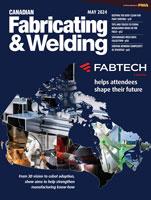- FMA
- The Fabricator
- FABTECH
- Canadian Metalworking
Mark to last
Direct Part Marking (DPM) is intended to deliver a ‘cast in stone’ permanence long after a label, ink mark, or sticker has worn away.
- By Canadian Metalworking
- March 13, 2014
- Article
- Metal Finishing

How durable can part marking be? This is the serial number from one of the F1 rocket engines that propelled Apollo 11 to the moon 44 years ago. It was recently recovered from the bottom of the Atlantic Ocean by a Bezos Family Foundation expedition. Image courtesy space.com
Direct Part Marking (DPM) is intended to deliver a ‘cast in stone’ permanence long after a label, ink mark, or sticker has worn away. This form of part tracking presents the challenge of serialization, identification and test data to be retrievable many years after manufacture.
Sometimes that legibility is meant for camera-reading devices. Newly expanded capabilities of DPM technologies can replace previous common and complex methods. Can an automatically controlled stylus write as well as a manual engraving tool, chemical etching, or ink?
Yes, with consistency and minus any toxic chemicals or fading. Automatic update of codes with relation to date and time, plus the ability to issue relevant data to ‘print’ test results on a part surface directly ‘certifies’ a product and can inhibit counterfeiting.
What is going to happen to the part after it is marked? Do coatings and other surface altering processes come into play? Can a stylus etch a complex logo or diagram on a hardened steel (60RHC) part?
Yes, and with a true type font if need be.
Dual valve control or spring return pneumatic stylus and electromagnetic stylus developments have come a long way recently. Microdot and Scribe markers, using tungsten carbide tools, have stepped out of the box to provide new answers for your marking needs. These developments address the challenges of quality part marking over a wide variety of surface shapes and materials. The consumables of such systems are o-rings and springs, but the stylus tip can be economically re-sharpened to a degree before needing replacement.
Legibility and consistency is not only key for human readable data but also for camera/readers. Recent designs in stylus and scribe marking can meet requirements on metals, plastics and even certain types of rubber surfaces, tasks once reserved for lasers.
This improved technology can result in cost savings in equipment, system configuration, consumables, and maintenance over other marking methods.
Let’s have a look what advantages are gained when implementing the correct Microdot or Scribe marking methods.
Small characters for small spaces: the construction of a Microdot and Scribe stylus has the tungsten carbide tip travelling up and down at a controlled adjustable frequency within a bearing-like surface for precision movement. This higher resolution makes for quality marks that are very legible even at only 1mm character size. The height, width, and depth of the characters produced by the low stress impact stylus are programmable for print to fit.
Part geometry challenges: Shafts, tubing, and varied shapes — some Microdot stylus models have an adjustable ‘throw’ of up to 14mm and maintain mark consistency. This allows for a ‘gray zone’ suited to produce even depth marking on curved and varied and even bevelled surfaces. The need to move the marker or the part may no longer be necessary for small variances when the stylus reaches out to do all the work.
Deep marking prior to coating and treatment: some Micro dot stylus tips with beveled points can mark as much as 1mm deep into mild steel using a pneumatic Microdot marker. Parts can be painted, treated, even galvanized afterwards with legible results.
Portability with versatility: small, low weight portable units can be adjusted to accommodate deep marking prior to paint pipes, weldments, and fabrications, yet be versatile enough to mark a thin nameplate or metal tube. Bracket-column design quickly converts a portable to a bench top operator marking station. This spreads the utility of a Microdot marker to return investment.
Marking of diagrams, shapes, and logos: A Microdot or Scribe marker can act as a ‘drawing machine’ for diagrams, logos, shapes, and symbols to be permanently marked on the part or nameplate.
Quality marking of fonts: There is almost no limit to have a desired font on the part or nameplate. The marker controller is smart enough to allow for downloads of true type fonts from the Internet and applied to the part surface.
Marking for a camera: a Microdot stylus can address a part surface in four ways. Each programmable approach is meant to produce a camera legible DPM without the need to prepare the surface beforehand. ECC200 encryption codes in line and dot, dots only, line and circles, and even squares are possible. Dot size is controlled by strike force, repetition, and stylus tip shape. This method can allow some plastics to be ECC200 coded along with human readable text.
Marking areas, obstacles, and projections on parts: command of the stylus is possible in three or more axes of motion. A program can contain instructions to move around a projection, mark into a channel, and instead of returning to a home position, go to a park position with relation to the part geometry for effective cycle time and motion.
These units come in a variety of models and marking areas, even in the form of a SCARA robot arm to 'reach’ into a subassembly to accurately mark it despite obstructions. One marking head comes with a 500 x 300mm marking zone to mark perhaps a tray of 64 parts all at one go. These sustainable and versatile tools act as miniature machine tools doing what they are engineered to do — write on metal and material.
Attaching a Z and W-axis option converts the marker into a small machining system, able to rotate the part, synchronize for diagrams and logos, and adjust for variations in height. Marking heads can also be mounted on actuators and robot end effectors to take the marker to the part. Again, the stylus is made to do all the work.
Engraving hollow metal with less noise: a Scribe stylus uses low air pressure to strike and drag on the hollow metal surface to ‘engrave’ characters and diagrams onto the part for a continuous line, high quality mark done quietly. The only sound you hear is a slight tapping noise of the stylus when it rises up and down between characters and shapes. Laser markers have come out of the laboratory — there are a number of enhanced capabilities that applications can benefit from.
Laser markers built for factory automation: One might ask if laser marking is the optimum choice for a truly permanent mark on metals, plastics, and a wide variety of other materials. Altering the colour of a material (or coating) with foaming, annealing, etching and engraving are the common techniques used in laser marking.
Digital self-calibrating galvos allow for installation of lasers on multi axis applications. These high-speed galvos are used for on-the-fly marking via encoder feedback. Internal reflective filters mean that you can mark polished shiny surfaces without fear of damaging the laser. Theoretically a fiber laser is designed for a MTBF of 100,000 marking hours.
Recently, laser markers have come down in price, up in reliability, and feature telediagnostics for real time support and remote analysis. Remote analysis is a key element in keeping uptime in the marking process. High contrast marking is now obtainable on materials like aluminum by expansion of the frequency range of the fiber laser diode control.
A CO2 laser marker can be used for clearly marking of plastics, wood, glass, leather and other materials.
Fiber lasers with modest wattages (12 to 40) can provide surface prep prior to marking to increase the level of contrast, especially on cast or rough metal surfaces.
Do your direct part marking (DPM) diligence:
These improvements in direct part marking technologies can meet new challenges of part geometry, depth, quality, noise issues, camera legibility, integration, and even act as a drawing machine. It is essential to get your
part samples test marked for feasibility, cycle time, and best marker package for the job and budget. Obtaining that ‘proof in hand’ helps assure your projects’ success.
Ted Januz is sales manager for Robert I. Robotics Inc. the firm has been in the DPM business since 1993, providing a wide variety of marking solutions including installation assistance, spare parts, and support services. Robert I. Robotics offers a wide
selection of Microdot, Scribe, Fiber Lasers and CO2 Lasers from RMU Marking.
About the Author
subscribe now


Keep up to date with the latest news, events, and technology for all things metal from our pair of monthly magazines written specifically for Canadian manufacturers!
Start Your Free Subscription- Industry Events
MME Saskatoon
- May 28, 2024
- Saskatoon, SK Canada
CME's Health & Safety Symposium for Manufacturers
- May 29, 2024
- Mississauga, ON Canada
DiPaolo Machine Tools Open House 2024
- June 4 - 5, 2024
- Mississauga, ON Canada
FABTECH Canada
- June 11 - 13, 2024
- Toronto, ON Canada
Zoller Open House & Technology Days 2024
- June 12 - 13, 2024
- Ann Arbor, MI























